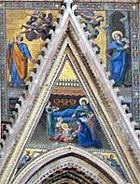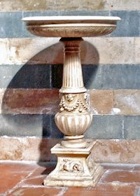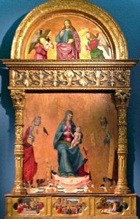“Jacopo da Bologna” is first documented in Orvieto, where he worked in the Duomo in the period 1485-95. He is also documented in 1493 in the team working under Pintoricchio on the Borgia Apartments of the Vatican Palace in Rome. He spent the rest of his life there. He was famous in his lifetime for having scaled the Column of Trajan: the device that he made in order to make detailed drawings (ca. 1500) of the reliefs there caused a sensation. Some of these drawings survive in the British Museum, London and in the Musée du Louvre, Paris.
Pope Alexander VI consequently commission him to fresco four rooms in the Palazzo dei Conservatori with scenes from classical history. The frescoes of the Sala di Annibale and the Sala della Lupa survive, at least in part.
Orvieto
While some scholars doubt that the “Jacopo da Bologna” who was documented at work in the Duomo in the period 1485-95 is the same as the “Jacopo Ripanda” who subsequently worked in Rome, the consensus is that they were, in fact, the same artist.
Duomo
Facade Mosaics (1485-95)
The first major restoration of the mosaics on the facade of the Duomo probably began in 1484, when the Opera del Duomo began a search for qualified artists who could repair what was by that time a considerable amount of deterioration. Jacopo Ripanda da Bologna is documented in 1485-95 in connection with the subsequent restoration programme.

-
✴the annunciation to St Joachim (1487-92) is by Jacopo Ripanda da Bologna; and
-
✴the annunciation to St Anne (1618-40) is attributed to Gabriele Mercanti.
Frescoes of the Tribune (1485-95)
Jacopo Ripanda da Bologna is also documented at this period at work on the frescoes of the “balcone" (balcony) of the choir in the tribune of the Duomo. His workshop here included:
-
✴Antonio del Massaro da Viterbo, il Pastura, in 1489-92; and
-
✴Giovanni Francesco d' Avanzarano, il Fantastico, in 1490.
Gilding of a Water Stoup (1486)

St Juvenal Altarpiece (ca. 1490)

-
✴Christ blessing with angels, in the lunette;
-
✴the Madonna and child enthroned against a gold background, with (now ruined) figures of SS Juvenal and Sabinus to the sides; and
-
✴three scenes from the life of St Juvenal in the predella:
-
•Pope Damasus consecrates St Juvenal as Bishop of Narni;
-
•St Juvenal preaches Narni; and
-
•a pagan commits suicide after he has assaulted St Juvenal.
The main panel is attributed to Jacopo da Bologna, while members of the workshop that he directed in the Duomo in 1485-95 seem also to have been involved:
-
✴the lunette is attributed to Antonio del Massaro da Viterbo, il Pastura; and
-
✴the predella panels are attributed to Giovanni Francesco d' Avanzarano, il Fantastico.



